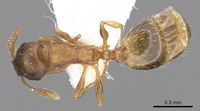Temnothorax ariadnae
| Temnothorax ariadnae | |
|---|---|

| |
| Scientific classification | |
| Kingdom: | Animalia |
| Phylum: | Arthropoda |
| Class: | Insecta |
| Order: | Hymenoptera |
| Family: | Formicidae |
| Subfamily: | Myrmicinae |
| Tribe: | Crematogastrini |
| Genus: | Temnothorax |
| Species group: | nylanderi |
| Species complex: | parvulus |
| Species: | T. ariadnae |
| Binomial name | |
| Temnothorax ariadnae Csösz, Heinze & Mikó, 2015 | |
This diurnal species is common in deciduous forests on Crete, especially in those dominated by oaks. Nests are under stones or in litter, usually in shady localities close to streams or in humid soil. Colonies monogynous (Salata, Borowiec & Trichas, 2018).
Identification
Csösz et al. (2015) - A member of the parvulus species-complex. This species shares most characteristics of its surface sculpture and shape with Temnothorax helenae and Temnothorax parvulus. Values of the propodeal spine length ratio (SPST/CL) for nest sample means perfectly separate T. parvulus (mean: 0.282 [min: 0.259, max: 0.303]) and T. ariadnae (mean: 0.216 [min: 0199, max: 0.227]). The geographical range of T. ariadnae and T. parvulus does not overlap and more complicated means of separating single individuals are therefore not needed.
The separation of T. ariadnae and T. helenae can be more difficult, because both taxa co-occur in Crete and various body ratios overlap. A discriminant (D4 = -0.0932_PPL -0.0767_POC +0.1203_PL -0.0384_SPWI +9.827) function is the shortest formula that yields reliable separation for single individuals (99.4%) and nest sample means (100%) of T. ariadnae and T. helenae.
Temnothorax ariadnae can be easily separated from two additional species whose distributional range expands to Crete, Temnothorax lucidus and Temnothorax subtilis, based on the shiny surface of the head dorsum of the two latter. In exceptional cases, or if dust cover obstructs a clear view of the surface sculpture, body ratios help to distinguish T. ariadnae from T. subtilis by the longer head (CL/CWb), the larger eyes (EL) and the longer propodeal spines (SPST/CS) and from T. lucidus by the non-overlapping NodL/CS, lower NOL/CS ratio and the longer head.
Salata et al. (2018), for Crete - Temnothorax ariadnae together with Temnothorax helenae, Temnothorax lucidus and Temnothorax subtilis are members of the T. nylanderi species group recorded from Crete. This group is characterized by presence of metanotal groove, brown to yellow body coloration, completely yellow antennae and well-developed head and mesosoma sculpture. Temnothorax ariadnae and T. helenae can be distinguished from other Cretan members of this group by dark yellow to yellowish-brown body colouration, head slightly longer than wide and presence of rugoso-reticulate sculpture on the head surface. Both species are extremely similar and difficult to distinguish. Temnothorax ariadnae differs from T. helenae in head sculpture. In T. helenae longitudinal striation occurs on the whole head surface and rugoso-reticulate area is limited to the center of frons. Whereas in T. ariadnae head is mostly rugoso-reticulate and longitudinal striation, if occurs, is limited to outer edges of frons. In series of specimens is also visible difference in body coloration – specimens of T. ariadnae are generally slightly darker yellow to yellowish-brown coloured than usually pale yellow specimens of T. helenae. Temnothorax lucidus and T. subtilis can be distinguished from other members of the T. nylanderi group from Crete by partly reduced head striation (frons at least partly smooth and shiny). According to original description (Csősz et al. 2015) T. lucidus has longer propodeal spines and frons are smooth and shiny on the almost whole surface while T. subtilis has smooth area limited to the center of frons. In order to separate these two species following discriminant function can be also used: D4 = +0.0717*EL +0.0778*NOH +0.0404*SPST -0.0824*SPBA -10.32, T. subtilis = -2.056 [-4.256, +0.259], T. lucidus = +2.098[-0.146, +6.298] (more detailed description see Csősz et al. 2015: 27).
Keys including this Species
Distribution
Endemic to Crete.
Latitudinal Distribution Pattern
Latitudinal Range: 35.326944° to 35.0922°.
| North Temperate |
North Subtropical |
Tropical | South Subtropical |
South Temperate |
- Source: AntMaps
Distribution based on Regional Taxon Lists
Palaearctic Region: Greece (type locality).
Distribution based on AntMaps
Distribution based on AntWeb specimens
Check data from AntWeb
Countries Occupied
| Number of countries occupied by this species based on AntWiki Regional Taxon Lists. In general, fewer countries occupied indicates a narrower range, while more countries indicates a more widespread species. |

|
Estimated Abundance
| Relative abundance based on number of AntMaps records per species (this species within the purple bar). Fewer records (to the left) indicates a less abundant/encountered species while more records (to the right) indicates more abundant/encountered species. |

|
Biology
- Queen number: monogynous (Salata, Borowiec & Trichas, 2018)
Castes
Worker
Images from AntWeb
   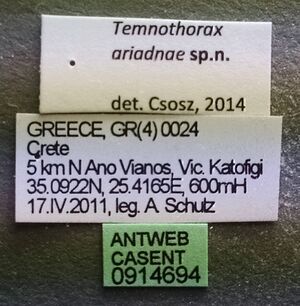
| |
| Worker. Specimen code casent0914694. Photographer Michele Esposito, uploaded by California Academy of Sciences. | Owned by CAS, San Francisco, CA, USA. |
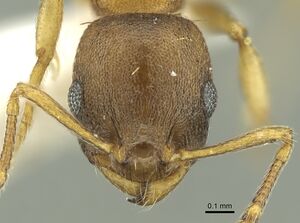   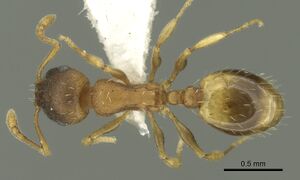 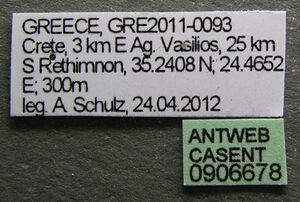
| |
| Worker. Specimen code casent0906678. Photographer Michele Esposito, uploaded by California Academy of Sciences. | Owned by CAS, San Francisco, CA, USA. |
Queen
Images from AntWeb
   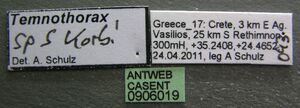
| |
| Queen (alate/dealate). Specimen code casent0906019. Photographer Estella Ortega, uploaded by California Academy of Sciences. | Owned by PCAS, Andreas Schulz Collection. |
Nomenclature
The following information is derived from Barry Bolton's Online Catalogue of the Ants of the World.
- ariadnae. Temnothorax ariadnae Csösz, Heinze & Mikó, 2015: 42, figs. 25A-C (w.) GREECE.
Unless otherwise noted the text for the remainder of this section is reported from the publication that includes the original description.
Description
Worker
Body color: brown; yellow. Body color pattern: mesosoma, antenna and legs, waist and anterior region of 1st gastral tergite lighter than head dorsum and posterior region of gaster. Antenna color pattern: clava concolorous funicle. Absolute cephalic size: 533–557 μm (mean = 543, n = 5). Cephalic length vs. Maximum width of head capsule (CL/CWb): 1.196–1.293 (mean = 1.223). Postocular distance vs. cephalic length (PoOc/CL): 0.373–0.393 (mean = 0.386). Postocular sides of cranium contour frontal view orientation: converging posteriorly. Postocular sides of cranium contour frontal view shape: strongly convex. Vertex contour line in frontal view shape: straight. Vertex sculpture: main sculpture absent, ground sculpture areolate. Genae contour from anterior view orientation: converging. Gena contour line in frontal view shape: convex. Gena sculpture: rugoso-reticulate with areolate ground sculpture. Median region of antennal rim vs. frontal carina in frontal view structure: not fully overlapped by frontal carina. Concentric carinae laterally surrounding antennal foramen count: present. Eye length vs. absolute cephalic size (EL/CS): 0.260–0.266 (mean = 0.263). Frontal carina distance vs. absolute cephalic size (FRS/CS): 0.346–0.369 (mean = 0.356). Longitudinal carinae on median region of frons count: absent. Smooth median region on frons count: absent. Antennomere count: 12. Scape length vs. absolute cephalic size (SL/CS): 0.758–0.795 (mean = 0.775). Facial area of the scape absolute setal angle: 0–15°. External area of the scape absolute setal angle: 30°; 35–45°. Ground sculpture of submedian area of clypeus: smooth. Median carina of clypeus count: present. Lateral carinae of clypeus count: present. Median anatomical line of propodeal spine angle value to Weber length in lateral view: 45–50°. Spine length vs. absolute cephalic size (SPST/CS): 0.220–0.249 (mean = 0.237). Minimum spine distance vs. absolute cephalic size (SPBA/CS): 0.248–0.287 (mean = 0.278). Maximum spine distance vs. absolute cephalic size (SPWI/CS): 0.303–0.336 (mean = 0.314). Apical spine distance vs. absolute cephalic size (SPTI/CS): 0.289–0.322 (mean = 0.300). Maximum mesosoma width vs. absolute cephalic size (MW/CS): 0.602–0.618 (mean = 0.611). Metanotal depression count: present. Metanotal depression shape: shallow. Dorsal region of mesosoma sculpture: rugulose with areolate ground sculpture. Lateral region of pronotum sculpture: areolate ground sculpture, main sculpture forked costate. Mesopleuron sculpture: areolate ground sculpture superimposed by dispersed rugulae. Metapleuron sculpture: areolate ground sculpture superimposed by dispersed rugulae. Frontal profile of petiolar node contour line in lateral view shape: concave. Anterodorsal rim of petiole count: absent medially. Dorsal profile of petiolar node contour line in lateral view shape: strongly convex. Dorsal region of petiole sculpture: ground sculpture areolate, main sculpture dispersed rugose; ground sculpture areolate, main sculpture absent. Dorso-caudal petiolar profile contour line in lateral view shape: straight; concave. Dorsal region of postpetiole sculpture: ground sculpture areolate, main sculpture dispersed rugose; ground sculpture areolate, main sculpture absent.
Type Material
Holotype: GER:024 Greece, Crete, 5 km N Ano Vianos, Vic. Katofigi, 35.0922 N, 25.4165 E, 60 mH, 17.04.2011, leg. A. Schulz, (Hungarian Natural History Museum), [GRE:Crete-Ano-Vianos-5N-20110417-024]; Paratypes: GER:024 Greece, Crete, 5 km N Ano Vianos, Vic. Katofigi, 35.0922 N, 25.4165 E, 60 mH, 17.04.2011, leg. A. Schulz, (5## HNHM, 2## California Academy of Sciences, CASENT0914694), [GRE:Crete- Ano-Vianos-5N-20110417-024]; GRE:092 Greece, Crete, 3 km E Ag. Vasilios, 25 km S Rethimnon, 35.2408 N, 24.4652 E, 300mH, 24.04.2011, leg. A. Schulz, (5## HNHM), [GRE: Crete-Ag-Vasilios-3E-20110424-092]; GRE:093 Greece, Crete, 3 km E Ag. Vasilios, 25 km S Rethimnon, 35.2408 N, 24.4652 E, 300mH, 24.04.2011, leg. A. Schulz, (3## HNHM, 2## CAS CASENT0906020, CASENT0906678), [GRE:Crete-Ag-Vasilios-3E-20110424-093]; GRE:037 Greece, Crete, Lassithi Plateau, 16 km S Malia, 35.1623 N, 25.4560 E, 1000mH, 18.04.2011, leg. A. Schulz, (3## HNHM, 1# CAS), [GRE:Crete-Malia16S-20110418-037].
Etymology
The name of this Cretan endemic species is dedicated to Ariadne, the daughter of king of Crete, Minos. In Greek mythology, her figure is closely connected with Minotaur’s labyrinth in Crete.
References
- Csösz, S., Heinze, J. & Mikó, I. 2015. Taxonomic synopsis of the Ponto-Mediterranean ants of Temnothorax nylanderi species-group. PLoS ONE. 10(11):e0140000. 62 pp. (doi:10.1371/journal.pone.0140000).
- Salata, S., Borowiec, L. 2019. Preliminary division of not socially parasitic Greek Temnothorax Mayr, 1861 (Hymenoptera, Formicidae) with a description of three new species. ZooKeys 877: 81-131 (doi:10.3897/zookeys.877.36320).
- Salata, S., Borowiec, L., Trichas, A. 2018. Taxonomic revision of the Cretan fauna of the genus Temnothorax Mayr, 1861 (Hymenoptera: Formicidae), with notes on the endemism of ant fauna of Crete. Annales Zoologici (Warsaw) 68(4): 769-808 (DOI 10.3161/00034541ANZ2018.68.4.004).
- Salata, S., Borowiec, L., Trichas, A. 2020. Review of ants (Hymenoptera: Formicidae) of Crete, with keys to species determination and zoogeographical remarks. Monographs of the Upper Silesian Museum No 12: 5–296 (doi:10.5281/ZENODO.3738001).
References based on Global Ant Biodiversity Informatics
- Salata S., L. Borowiec, and A.Trichas. 2018. Taxonomic Revision of the Cretan Fauna of the Genus Temnothorax Mayr, 1861 (Hymenoptera: Formicidae), with Notes on the Endemism of Ant Fauna of Crete. Annales Zoologici (Warsaw) 68(4): 769-808.
- Salata S., and L. Borowiec. 2018. A new species of the ant genus Lasius Fabricius, 1804 from Crete (Hymenoptera, Formicidae). ZooKeys 789: 139–159.
- Salata S., and L. Borowiec. 2018. Taxonomic and faunistic notes on Greek ants (Hymenoptera: Formicidae). Annals of the Upper Silesian Museum in Bytom Entomology 27: 1-51.

